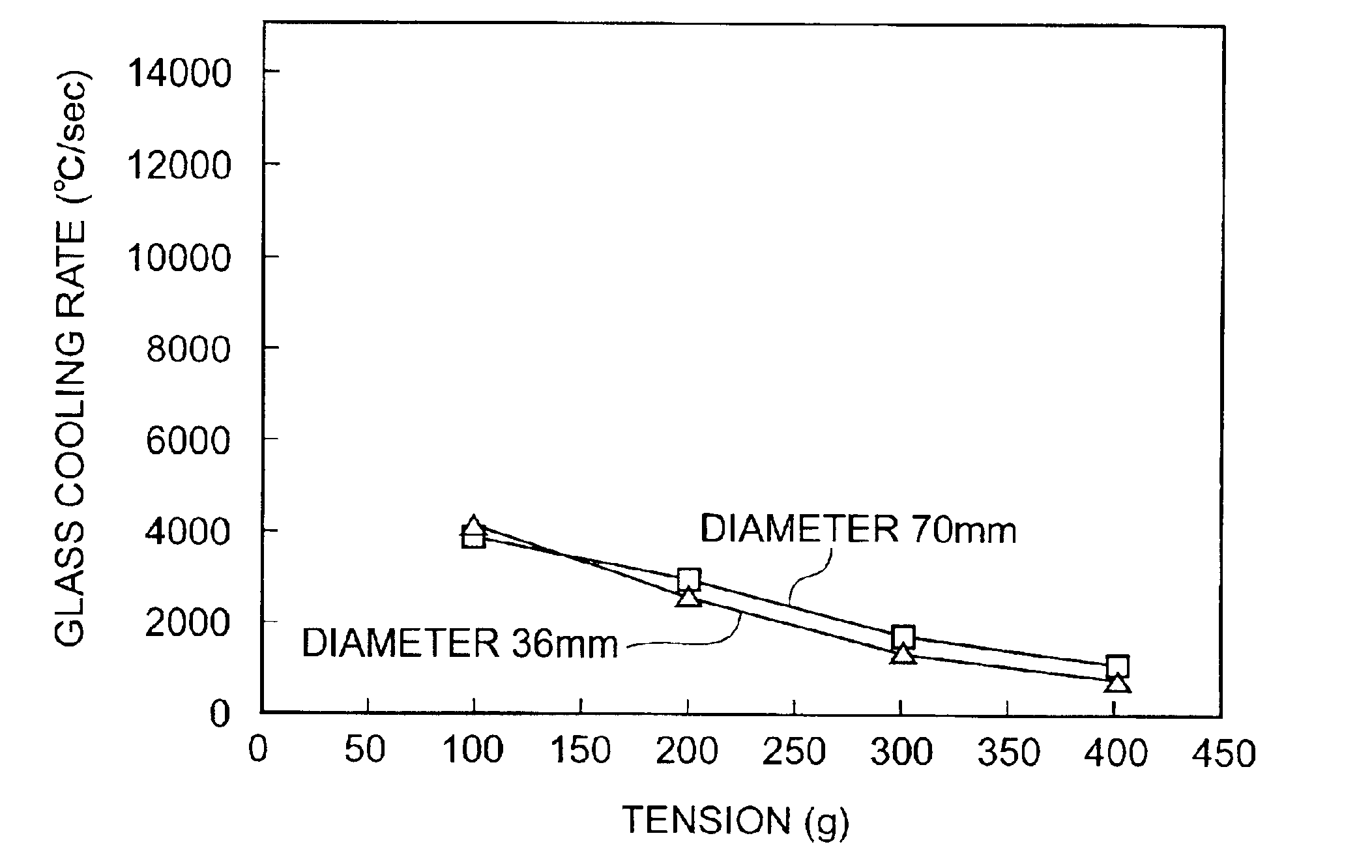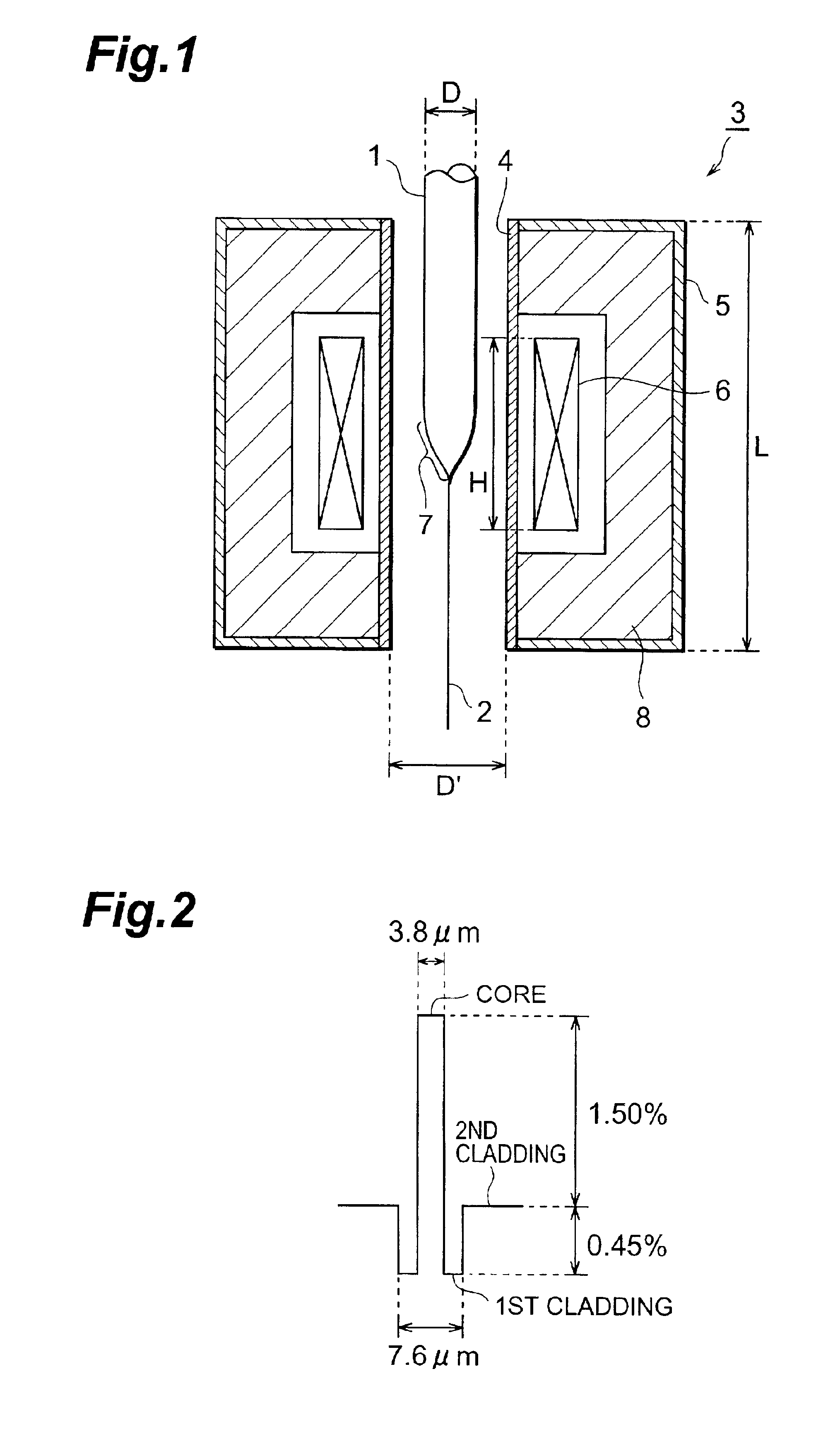Method of manufacturing optical fiber
a manufacturing method and technology of optical fiber, applied in the field of manufacturing optical fiber, can solve the problems of difficult mass production efficiency, inability to meet the requirements of hydrogen characteristic, and non-bridging oxygen hole center, etc., and achieve the effect of efficient and reliable production, excellent effect, and insufficient efficiency and accuracy
- Summary
- Abstract
- Description
- Claims
- Application Information
AI Technical Summary
Benefits of technology
Problems solved by technology
Method used
Image
Examples
example 1
[0037]An optical fiber preform having a diameter (D) of 36 mm was inserted into a core tube of a drawing furnace having the configuration shown in FIG. 1 in which the core tube had an inner diameter (D′) of 45 mm, the furnace body had a length (L) of 250 mm in the drawing direction, and the heater had a length (H) of 130 mm in the drawing direction, and was drawn at a line speed of 100 m / min while being softened upon heating in a nitrogen atmosphere with the heater temperature being set at 1950° C., whereby an optical fiber having a diameter of 125 μm was obtained. Here, the glass cooling rate at the time when the optical fiber attained a temperature of 1800° C. was 87.41° C. / sec.
[0038]Concerning thus obtained optical fiber, the amount of change in transmission loss of light having a wavelength of 1.38 μm (Δα1.38 [dB / km]) between before and after exposure to an atmosphere of a mixed gas composed of 1% by volume of hydrogen and 99% by volume of nitrogen at 80° C. for 20 hours was mea...
examples 2 to 5
[0039]Optical fibers each having a diameter of 125 μm were prepared as in Example 1 except that the glass cooling rate at the time when the optical fibers attained a temperature of 1800° C. was changed as shown in Table 1, and Δα1.38 was measured. Table 1 shows thus obtained results.
examples 6 to 8
[0040]Optical fibers each having a diameter of 125 μm were prepared as in Example 1 except that the line speed was 200 m / min and that the glass cooling rate at the time when the optical fibers attained a temperature of 1800° C. was changed as shown in Table 1, and Δα1.38 was measured. Table 1 shows thus obtained results.
[0041]
TABLE 1Line speedGlass cooling rateΔα 1.38[m / min][° C. / sec][dB / km]Example 110087.410.000Example 210069.960.010Example 3100666.80.150Example 4100896.00.160Example 510016440.390Example 6200767.10.230Example 720013630.320Example 820030940.640
PUM
| Property | Measurement | Unit |
|---|---|---|
| Temperature | aaaaa | aaaaa |
| Fraction | aaaaa | aaaaa |
| Pressure | aaaaa | aaaaa |
Abstract
Description
Claims
Application Information
 Login to View More
Login to View More - R&D
- Intellectual Property
- Life Sciences
- Materials
- Tech Scout
- Unparalleled Data Quality
- Higher Quality Content
- 60% Fewer Hallucinations
Browse by: Latest US Patents, China's latest patents, Technical Efficacy Thesaurus, Application Domain, Technology Topic, Popular Technical Reports.
© 2025 PatSnap. All rights reserved.Legal|Privacy policy|Modern Slavery Act Transparency Statement|Sitemap|About US| Contact US: help@patsnap.com



